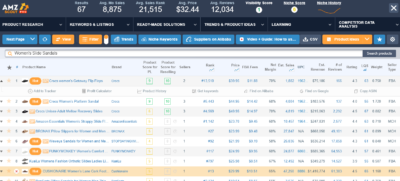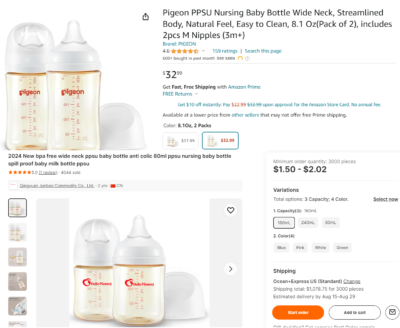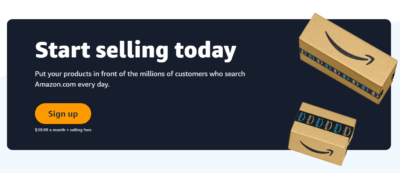Starting an Amazon business with a limited budget can be a daunting task. However, with the right strategy and approach, it is possible to turn a small investment into a profitable venture. In this article, we will explore a straightforward method to generate quick profits on Amazon, broken down into five essential steps.
Starting Out
When starting an Amazon business, it’s crucial to identify products that have high demand and low competition. This method will allow you to sell items at a higher price and maximize your profits.
Steps to Start Your Amazon Business in 2024:
Here are the five basic steps to making money on Amazon:
- Choosing a sourcing method
- Analyzing selected products
- Developing a pricing strategy
- Setting up a seller’s account
- Fulfilling orders
Let’s delve into each of these steps in detail to help you launch your Amazon business successfully.
Step 1: Choosing the Right Sourcing Method
It’s important to determine where and how you will acquire products to sell. Whether you purchase items wholesale, find discounted products from various retailers, or create your own products, the goal is to find reliable sources that offer quality products at competitive prices.
Depending on your business model, there are various common ways to source products:
- Retail Arbitrage: This involves manually searching for products to sell on Amazon by visiting physical retail stores, such as discount stores or clearance sales. While this process can uncover unique and profitable products, it is time-consuming and requires significant effort.
- Online Arbitrage: Similar to retail arbitrage, but done online. This method involves finding discounted or lower-priced products on other online marketplaces and reselling them on Amazon. It can save travel time and allows for a broader range of products to be sourced.
- Wholesale Purchasing: Buying products in bulk directly from manufacturers or distributors. This method can provide consistent inventory and lower per-unit costs but often requires a larger upfront investment.
- Private Labeling: Creating your own brand by sourcing generic products from manufacturers and selling them under your own label. This method can differentiate your products from competitors and build brand loyalty, though it requires time and effort to develop and market your brand.
- Dropshipping: Partnering with suppliers who handle inventory and shipping. When you make a sale on Amazon, the supplier ships the product directly to the customer. This method reduces upfront costs and inventory management but often results in lower profit margins.
Using a combination of these sourcing methods can provide flexibility and help you maximize profits. It’s important to research and choose the methods that align with your business goals and resources.
Step 2: Analyzing Product Profitability
The success of any Amazon business hinges on the ability to identify profitable products. To streamline your product search and enhance your chances of success, follow these general suggestions:
- Price Range: Choose products priced between $15 and $50. Items in this range tend to sell relatively quickly and offer a balance between affordability and profitability. This range helps you avoid cheap items that don’t generate significant profit.
- Size and Weight: Stick to small and lightweight products. These items incur lower shipping costs due to their reduced weight and compact size, which also allows for more efficient storage. This approach helps you save money on shipping and storage.
- Demand and Competition: Focus on products with high demand and low competition. Initially, target products that have more than 10,000 sales but fewer than 100 reviews. This balance ensures that there is a market for the product without overwhelming competition.
- Seasonal Products: Be cautious with seasonal products, such as snow boots, which are only popular for a short period each year. If you decide to sell these items, plan for the inevitable decline in sales during off-seasons.
- Gated Products: Avoid gated products, which require additional certifications or licenses to sell. These products can be difficult to list and may involve complex approval processes. Be prepared to account for the extra effort and steps necessary to sell these items.
If you want to check how well your selected product will sell, you can use some of Amazon’s seller tools. To thoroughly analyze the product niche and check potential profits, try the AMZScout PRO Extension.

Here are some important metrics every seller should consider, along with tips on what to pay attention to when analyzing which products to resell:
- Profit Margins: Focus on products with margins over 30% to maximize your profits and ensure a healthy return on investment.
- Estimated Monthly Sales: A product with at least 300 sales per month is considered to have a good level of demand and potential for profitability.
- Stable Demand: Check the sales history to ensure the product has had good sales over the last year, indicating stable demand.
- Amazon Fees: Consider any fees associated with referring sales and using FBA logistics, as they can significantly impact your profit margins. Factor these fees into your pricing strategy when evaluating potential products to sell.
By prioritizing products with strong profit margins, stable demand, and manageable fees, you can build a successful Amazon business.
Product Example
Let’s check an example of a product you can start selling with just $1,000: a baby bottle priced at $29.99 on Amazon. Although baby products are generally recommended, we need to ensure profitability.

Using Alibaba, we found the product for $3 per item for smaller quantities, given our $1,000 budget.
Analysis Results
- Amazon Selling Price: $29.99
- Supplier Cost: $3 per item
- Amazon Fees: $9.50 per item (including FBA fees)
- Additional Costs (taxes, shipping, promotional costs, etc.): $2.50 per item
- Total Costs: $15 per item ($3 supplier cost + $9.50 Amazon fees + $2.50 additional costs)
With a budget of $1,000, we can buy:
- First Batch: 66 items (rounded down from $1,000 / $15 per item)
- Total Spend: $990 (66 items x $15 per item)
Profit Calculation
- Revenue from Sales: $1,979.34 (66 items x $29.99 selling price)
- Profit: $989.34 ($1,979.34 revenue – $990 total costs)
By using the Fulfillment by Amazon (FBA) program, we can leverage Amazon’s warehousing and shipping services. Assuming we can sell this batch within a month, we can expect a profit of $989.34 after selling the first batch of 66 items within our $1,000 budget.
Step 3: Developing a Pricing Strategy
Before officially starting our business, we need to have a clear understanding of the prices at which we will be selling our products. The minimum prices and Buy Box price from the calculator provide a starting point, but they should not be your final decision.
Here are some general tips and recommendations on how to set prices when reselling products on Amazon:
- Research the Competition: Check the prices of similar products on Amazon and other marketplaces to get an idea of the market value.
- Factor in Your Costs: Calculate all your costs, including the purchase price, shipping, taxes, and Amazon fees, to determine the minimum price at which you need to sell the product to make a profit.
- Set a Competitive Price: Price your product competitively to attract buyers and outperform your competitors.
- Monitor and Adjust Prices: Keep an eye on your product’s performance and adjust the price as needed to maximize your profits.
By following these guidelines, you can develop a pricing strategy that balances competitiveness with profitability, ensuring the success of your Amazon business.
Step 4: Registering as a Seller
If you wish to sell products on Amazon, you must first create a seller account, which will grant you access to Amazon Seller Central, where you will manage your account.

Here’s what you need to do to register as a seller:
- Visit Amazon’s registration page. You can use your existing Amazon account to save time, but make sure the information is accurate, as you will need to verify it later.
- Enter your name, address, and contact information.
- Verify your bank account.
- Submit photos of your ID.
- Receive a postcard with a code to verify your physical address.
- Complete a video interview with Amazon.
- Provide bank statements and forms of ID to confirm your identity.
You will also need to provide a valid payment card to sign up for an Amazon Individual or Professional Account. An Individual Account costs $0.99 per listing, while a Professional Account costs $39.99 per month with no additional charge per listing. Professional Accounts also offer more advertising features, which is ideal if you plan to sell more than 40 items per month.
Step 5: Last but not least: Fulfilling the Order
Now that we have selected our product, opened an account, and started making sales, it’s time to focus on managing and processing orders effectively. You have two main options for order fulfillment on Amazon: Fulfillment by Amazon (FBA) and Fulfillment by Merchant (FBM). Here are the key aspects of each option:
Fulfillment by Amazon (FBA)
- Storage and Shipping: Amazon handles storage, packing, and shipping.
- Prime Eligibility: Products are eligible for Amazon Prime, increasing sales potential.
- Customer Service and Returns: Amazon manages customer service and returns.
- Fees: Includes storage and fulfillment fees, which should be factored into your pricing.
Fulfillment by Merchant (FBM)
- Timely Order Fulfillment: Ensure fast and reliable shipping using integrated shipping software.
- Customer Service: Handle inquiries and complaints promptly to build customer loyalty.
- Inventory Management: Use software to track inventory levels and avoid stockouts.
- Cost Control: More cost-effective but requires hands-on management.
Choosing between FBA and FBM depends on your business needs and resources. By understanding and implementing best practices for each option, you can effectively manage your Amazon business.
Final Thoughts
Selling on Amazon is an excellent e-commerce business strategy for those who are always striving for more. You can try different products, explore various niches, compare items, and optimize your expenses. Believe in yourself, test your ideas, and you’re sure to achieve success with your first product.


